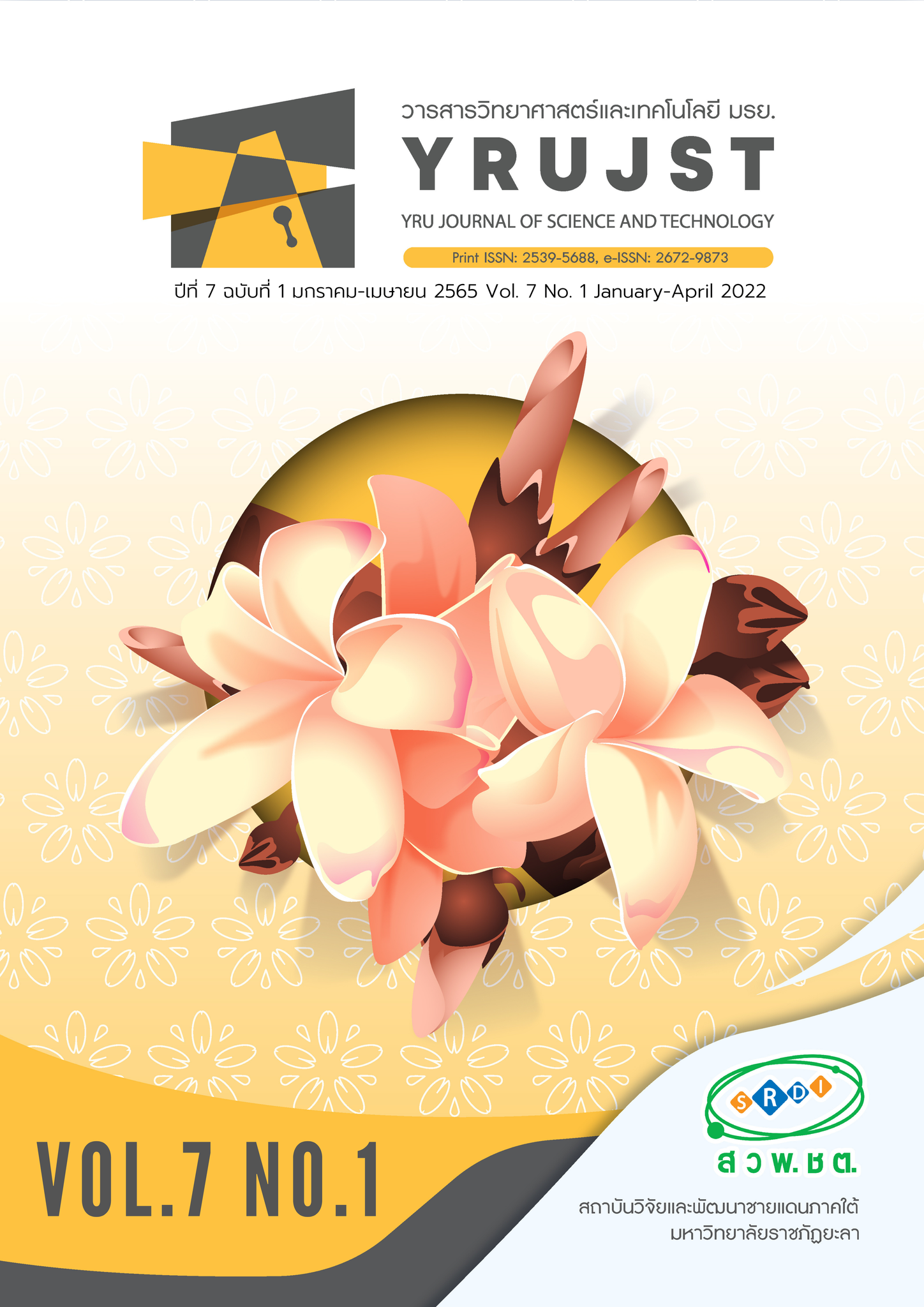Development of Cosmetic Product from corn silk extracts
Main Article Content
Abstract
This research aims to study the performance and optimum concentration of the extracts from corn silk as agricultural waste to inhibit pathogenic bacteria. The growth inhibition of ethyl acetate and water extracts is tested by using agar well diffusion and broth dilution against eight strains bacteria i.e., Serratia marcescens Salmonella typhimurium, Staphylococcus aureus, Escherichia coli, Bacillus cereus, Proteus vulgaris, Pseudomomas aeruginosa and Aeromonas hydrophila. It was found that the water extract of corn silk showed the highest antibacterial activity on B. cereus with inhibition zone of 8.83±1.69 mm. Moreover, the ethyl acetate extract of corn silk showed highest antibacterial activity against S. aureus with inhibition zone of 12.83±3.34 mm, MIC of 62.5 mg/mL and MBC of 125 mg/mL. In addition, corn silk cream provided formulations with good physical and chemical stability. The cream texture was stable without layer. This research is beneficial in promoting effective agricultural waste; corn silk with the use technology and innovation, benefit the community and also raise the standard of Thai cosmetic products and continue to commercial.
Article Details
บทความ ข้อมูล เนื้อหา รูปภาพ ฯลฯ ที่ได้รับการเผยแพร่ในวารสารวิทยาศาสตร์และเทคโนโลยี มรย. นี้ ถือเป็นลิขสิทธิ์ของวารสารวิทยาศาสตร์และเทคโนโลยี มรย. หากบุคคลหรือหน่วยงานใดต้องการนำทั้งหมดหรือส่วนหนึ่งส่วนใดไปเผยแพร่ต่อหรือกระทำการใดๆ จะต้องได้รับอนุญาตเป็นลายลักษณ์อักษรจากวารสารวิทยาศาสตร์และเทคโนโลยี มรย. ก่อนเท่านั้น
References
Choi, S.Y., Lee, Y., Kim, S.S., Ju, H.M., Baek, J.H., Park, C.S. & Lee, DH. (2014). Inhibitory effect of corn silk on skin pigmentation. Molecules, 19(3), 2808-2818.
Chuah, E.L., Zakaria, Z.A., Suhaili, Z., Bakar, S.A. & Desa, M.N.M. (2014). Antimicrobial activities of plant extracts against methicillin-susceptible and methicillin-resistant Staphylococcus aureus. Journal of Microbiology Research, 4(1), 6-13.
Helmy, A., El-shazly, M., Seleem, A., Abdelmohsen, U., Salem, MA., Samir, A., Rabeh, M., Elshamy, A. & Singab, A.N.B. (2020). The synergistic effect of biosynthesized silver nanoparticle from a combined extract of parsley, corn silk, and gum Arabic: in vivo antioxidant, anti-inflammatory and antimicrobial activities. Materials Research Express, 7, 1-16.
Insain, P. (2018). Inhibition of melanogenesis from Thai berries. EAU Heritage Journal Science and Technology, 12(2), 69-82. (in Thai)
Kim, Y.H., Cho, A., Kwon, S.A., Kim, M., Song, M., Han, H.W., Shin, E.J., Park, E. & Lee, S.M. (2019). Potential photoprotective effect of dietary corn silk extracts on ultraviolet B-induced skin damage. Molecules. 24(14), 1-21.
Koohsari, H., Ghaemi, EA., Sheshpoli, M.S., Jahedi, M. & Zahiri, M. (2015). The investigation of antibacterial activity of selected native plants from North of Iran. Journal of Medicine and Life, 8(2), 38-42.
Kumwing, S. (2018). Development of nourishing skin cream from Tubtim chum phae rice extract. Bachelor degree’ s Thesis. Nakhon Sawan Rajabhat University. (in Thai)
Leelapornpisid, P., Muangmai, L., Sirithunyalug, B. Jiranusornkul, S. & Peerapornpisal, Y. (2014). A novel moisturizer extracted from fresh water macroalga [Rhizoclonium hieroglyphicum (C. Agardh) Kützing] for skin care cosmetic. Chiang Mai Journal of Science, 41(5.2), 1195-1207.
Mishra, A.K., Yadav, P. & Mishra, A. (2016). A Systemic review on staphylococcal scalded skin syndrome (SSSS): a rare and critical disease of neonates. The Open Microbiology Journal, 10, 150-159.
Muangkote, S., Vichitsoonthonkul, T., Srilaong, V., Wongs-Aree, C. & Photchanachai, S. (2014). Inhibition of human bacterial pathogens from roasted garlic, shallot and dried chili crude extracts. Thai Journal of Agricultural Science, 45(2) (Supplement), 297-300. (in Thai)
Nawaz, H., Aslam, M. & Muntaha, S.T. (2019). Effect of solvent polarity and extraction method on phytochemical composition and antioxidant potential of corn silk. Free radicals and antioxidants, 9(1), 5-11.
Parkpoom, T. & Chantree, K. (2014). Detection of cross-contamination of pathogens in cosmetic products Containing Artocarpus lakoocha extract. SDU Research Journal, 7(3), 75-91. (in Thai)
Prompamorn, P. & Ratcharin, N. (2016). Evaluation of antibacterial activity and gel formulation development from Terminalia chebula Retz extract. SDU Research Journal, 9(1), 52-63. (in Thai)
Shahbaz, K. (2017). Cephalosporins: pharmacology and chemistry. Pharmaceutical and Biological Evaluations, 4(6), 234-238.
Tangsirisap, N. (2012). The in vitro study of antibacterial activity of unripe banana (Musa sapientum Linn.) peels extracts against bacteria causing acne vulgaris and common skin infections. Master’s Thesis. Srinakharinwirot University. (in Thai)
Tantipaibulvut, S., Nuamsetti, T. & Dechayuenyong, P. (2012). Antibacterial activity of some fruit-peel extracts. KKU Research Journal, 17(6), 880-894. (in Thai)
Tengkaew, S. & Wiwattanadate, D. (2014). Study of source and potential of biomass from field corn in Thailand. Princess of Naradhiwas University Journal, 6(3), 102-111. (in Thai)
Tharasawaeng, S., Sairuomyart, S. Tienungoon, S., Suphaphon, B., Bucha, P. & Chansuvanich, N. (2013). The study of herbal extracts of Ardisia elliptica Thunb. fruit and the fruit hull of Garcinia mangostana Linn. as a preservative in drugs and cosmetics. Thai Food and Drug Journal, 20(2), 30-36. (in Thai)


